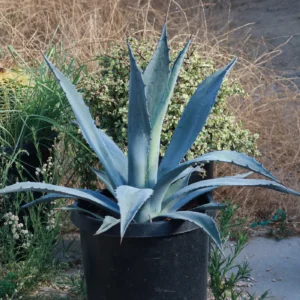Century Plant
Palm Overview
Botanical Name: Furcraea macdougallii
Looking to make a statement in your landscape? The Century Plant is your showstopper. With its massive, architectural rosette of blue-green, sword-like leaves and striking silhouette, this desert darling brings instant drama and timeless elegance to any setting.
But the real magic? It saves its biggest moment for last—after years of quiet strength, the Century Plant explodes into bloom with a spectacular flower stalk up to 30 feet tall, bursting with golden blossoms that attract hummingbirds, bees, and admiration from every passerby.
Plant Characteristics
| Characteristic | Description |
|---|---|
| Height | 4–6 feet (rosette); flower stalk reaches 15–30+ feet |
| Canopy Spread | 6–10 feet wide |
| Trunk | None (rosette grows at ground level) |
| Leaves/Fronds | Thick, blue-green to gray-green, sword-shaped with sharp marginal spines |
| Growth Rate | Slow to moderate; takes 10–30 years to flower |
| Lifespan | 10–30 years (dies after flowering but produces pups) |
Environmental Needs
| Environmental Factor | Requirement |
|---|---|
| Sunlight | Full sun (6+ hours daily); tolerates partial sun |
| Soil | Well-draining soil; sandy, rocky, or cactus mix preferred |
| Watering | Low water needs; drought-tolerant—water deeply but infrequently |
| Hardiness | USDA Zones 8–11; tolerates temperatures down to 15–20°F when established |
Fruit and Flowering
| Feature | Description |
|---|---|
| Flower Type | Large, tubular, yellow-green flowers |
| Flowering Time | Typically blooms once in its lifetime, usually after 10–30 years, mainly in late spring to summer |
| Flowering Habit | Monocarpic (dies after flowering) |
| Pollination | Attracts bats, hummingbirds, bees, and insects |
| Fruit Type | Capsule containing seeds |
| Seed Dispersal | Seeds released after fruit capsule dries and splits |
| Offshoots (Pups) | Produces vegetative pups from base to continue growth after the main plant dies |
Uses
Ornamental Focal Point: Striking architectural form makes it a standout in xeriscapes, desert gardens, and modern landscapes.
Drought-Tolerant Landscaping: Perfect for water-wise gardens, requiring minimal irrigation once established.
Erosion Control: Its robust root system helps stabilize soil on slopes and arid landscapes.
Fiber Production: Historically used for extracting strong fibers (maguey or pita) to make ropes, mats, and baskets.
Traditional Beverage: Source of sap for pulque, a traditional Mexican fermented drink.
Wildlife Habitat: Provides nectar for pollinators such as bats, bees, and hummingbirds.
Natural Barrier: Sharp spiny leaves can act as a living fence to deter animals or intruders.
Medicinal Uses: Traditional applications for minor skin irritations and wounds (use with caution due to sap irritants).
Cut Flower Stalks: The dramatic flower stalks can be used as natural decor elements after flowering.
Maintenance
Watering:
Water sparingly; allow soil to dry completely between waterings.
Reduce watering in winter; avoid overwatering to prevent root rot.
Sunlight:
Ensure full sun exposure for best growth and flowering.
Soil:
Plant in well-draining soil to avoid waterlogging.
Pruning:
Remove dead or damaged leaves carefully (wear gloves to avoid spines).
After flowering, cut back the spent flower stalk.
Pup Management:
Remove and transplant pups to propagate new plants or control crowding.
Pest Control:
Monitor for agave snout weevil; treat infestations promptly.
Watch for scale insects or fungal diseases and address if needed.
Winter Care:
In colder climates (below USDA Zone 8), provide frost protection or grow in containers that can be moved indoors.
Safety:
Wear protective gloves and clothing when handling to avoid injury from sharp leaf tips and sap.
